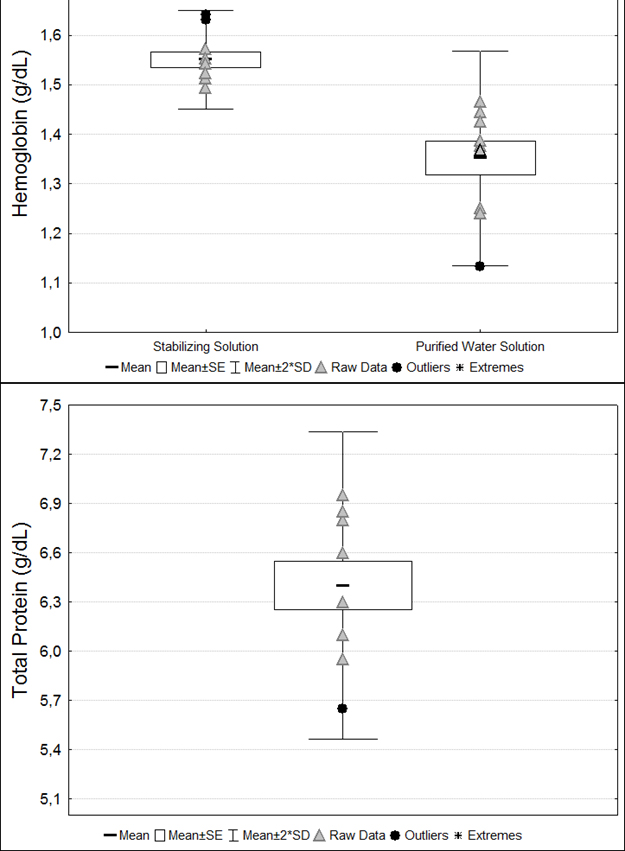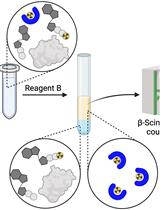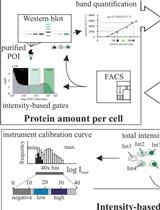- Submit a Protocol
- Receive Our Alerts
- EN
- EN - English
- CN - 中文
- Protocols
- Articles and Issues
- For Authors
- About
- Become a Reviewer
- EN - English
- CN - 中文
- Home
- Protocols
- Articles and Issues
- For Authors
- About
- Become a Reviewer
Blood AST, ALT and UREA/BUN Level Analysis
Published: Vol 3, Iss 19, Oct 5, 2013 DOI: 10.21769/BioProtoc.931 Views: 37740
Reviewed by: Lin Fang

Protocol Collections
Comprehensive collections of detailed, peer-reviewed protocols focusing on specific topics
Related protocols

Assessment of Oxidative Stress Biomarkers in Rat Blood
Yuri K. Sinzato [...] Débora C. Damasceno
Mar 5, 2023 604 Views

Measuring in vitro ATPase Activity with High Sensitivity Using Radiolabeled ATP
Sarina Veit and Thomas Günther Pomorski
May 20, 2023 507 Views

Protein Level Quantification Across Fluorescence-based Platforms
Hector Romero [...] M. Cristina Cardoso
Oct 5, 2023 539 Views
Abstract
AST (aspartate aminotransferase; GOT, glutamate oxalacetate transaminase) and ALT (alanine aminotransferase; GPT, glutamate pyruvate transaminase) are sensitive indicators to monitor the liver function under drugs treatment or with acute viral hepatitis. The elevated AST and ALT values in the blood sample indicate liver damage or injury. The determination of urea is the most widely used for the evaluation of kidney function. This protocol is for the quantitative determination of AST, ALT and UREA/BUN in serum and plasma on Roche automated clinical chemistry analyzers. The principle is shown below:
For AST:
α-ketoglutarate + L-aspartate ![]() L-glutamate + oxaloacetate (AST catalyzes this equilibrium reaction)
L-glutamate + oxaloacetate (AST catalyzes this equilibrium reaction)
oxaloacetate + NADH + H+ ![]() L-malate + NAD+ (malate dehydrogenase catalyzes this equilibrium reaction)
L-malate + NAD+ (malate dehydrogenase catalyzes this equilibrium reaction)
The rate of the photometrically determined NADH decrease is directly proportional to the rate of formation of oxaloacetate and thus the AST activity. The above reactions were carried out at 37 °C and measured at a wavelength of 340 nm.
For ALT:
α-ketoglutarate + L-alanine ![]() L-glutamate + pyruvate (ALT catalyzes this equilibrium reaction)
L-glutamate + pyruvate (ALT catalyzes this equilibrium reaction)
Pyruvate + NADH + H+ ![]() L-lactate + NAD+ (lactate dehydrogenase catalyzes this equilibrium reaction)
L-lactate + NAD+ (lactate dehydrogenase catalyzes this equilibrium reaction)
The rate of the photometrically determined NADH decrease is directly proportional to the rate of formation of pyruvate and thus the ALT activity. The above reactions were carried out at 37 °C and measured at a wavelength of 340 nm.
For UREA/BUN:
Urea + H2O → 2 NH4+ + CO2 (urea is hydrolyzed by urease)
α-ketoglutarate + NH4+ + NADH → L-glutamate + NAD+ + H2O (the presence of GLDH yields glutamate and NAD+)
The decrease in absorbance due to consumption of NADH is measured kinetically. The above reactions were carried out at 37 °C and measured at a wavelength of 340 nm.
Materials and Reagents
- Blood
- AST (GOT) detection kit (Roche, catalog number: 11876848216 )
- ALT (GPT) detection kit (Roche, catalog number: 11876805216 )
- UREA/BUN detection kit (Roche, catalog number: 11729691216 )
- Cuvette (Roche, catalog number: TA28 ) and sample cups (Roche, catalog number: 1105 )
- Calibrator for automated system (Roche, catalog number: 10759350 )
- Normal saline (0.9% w/v of NaCl) (see Recipes)
Equipment
- Microhematocrit blood tube (heparinized) (Assistant®, catalog number: 563 )
- Dropper (3 ml)
- Centrifuge (Eppendorf)
- Polypropylene test tube (Corning Incorporated, Axygen®, catalog number: MCT-150-C )
- Chemistry Analyzer (Roche, Cobas Mira Plus)
Procedure
- Collect blood from the orbital sinus with a microhematocrit blood tube (heparinized). Use dropper to push out the blood in the heparinized blood tube and collect about 300 μl blood in the 1.5 ml polypropylene test tube.
- Centrifuge at 1500 x g, 4 °C for 15 min. Carefully take the cell-free supernatant plasma (about half volume of blood) and place it in a properly labeled polypropylene test tube and transfer about 150 μl plasma into the sample cups.
- Use fresh plasma for blood AST, ALT and UREA/BUN level analysis.
- For analysis, it needs 100-150 μl sample volume in the sample cups. Put the sample cups containing plasma in the sample place and empty cuvettes in the detection place of Chemistry Analyzer. If the sample volume is not enough, it can be diluted with normal saline.
- Prepare the detection reagent according to the manufacturer’s instruction and transfer the prepared detection reagent into the reagent container for Chemistry Analyzer. It is easy to prepare the detection reagent by mixing R1 and R2 solution provided in the kit. Briefly, in AST and ALT reagent preparation, connect one bottle 1 to one bottle 1a to prepare R1 solution and then combine the volume of R1 and R2 in R1:R2 = 5:1 to get the detection reagent. For UREA/BUN detection reagent preparation, combine the volume of R1 and R2 in R1:R2 = 5:3. These mixed detection reagents are stable for 7 days at 4 °C.
- It needs to correct the Chemistry Analyzer with commercial calibrator before sample detection. The calibrator is as positive control and normal saline as negative control.
- After correction, it is ready to analyze AST, ALT and BUN levels of sample in Chemistry Analyzer.
- The automatic analysis steps for AST and ALT are:
- Aspirate 10 μl of plasma sample from sample cups into cuvette.
- Dilute sample with 40 μl of normal saline.
- Add 300 μl of detection reagent into cuvette.
- Begin to detect the values at 340 nm wavelength at different time points.
- Report the measured results.
- Aspirate 10 μl of plasma sample from sample cups into cuvette.
- For UREA/BUN analysis, the steps are:
- Aspirate 4 μl of plasma sample from sample cups into cuvette.
- Dilute sample with 20 μl of normal saline.
- Add 400 μl of detection reagent into cuvette.
- Begin to detect the values at 340 nm wavelength at different time points.
- Report the measured results.
- Aspirate 4 μl of plasma sample from sample cups into cuvette.
- The automatic analysis steps for AST and ALT are:
Notes
- The sensitivity of AST, ALT and UREA/BUN is 4 U/L, 4 U/L and 0.83 mmol/L, respectively. The measurement range of AST, ALT and UREA/BUN is 4-800 U/L, 4-600 U/L and 0.83-40.00 mmol/L, respectively.
- It is not necessary to repeatedly detect the values from the same sample because the program can monitor the values at different time points. If the variation of measured values in the sample is over 5%, the machine will automatically detect the sample again.
- In normal mice, the level of ALT, AST and UREA/BUN in plasma is ALT: 25-60 U/L; AST: 50-100 U/L; UREA/BUN: 16-30 mmol/L. The elevated values of ALT and AST indicate liver injury and high level of UREA/BUN indicates loss of kidney function.
Recipes
- Normal Saline (0.9% w/v of NaCl)
- Make sure all apparatus are clean, dry, and sterile.
- Weight 0.9 grams of sodium chloride. Dissolve the powder in about 80 ml distilled water by mixing gently with a stirring bar until all the powder has been dissolved. Add distilled water to a final volume of 100 ml.
- Transfer the prepared 0.9% sodium chloride solution (normal saline) in a storage bottle and label properly. Autoclave the solution.
- Make sure all apparatus are clean, dry, and sterile.
Acknowledgments
This protocol was adapted from the previously published paper, Sher et al. (2009). This work was supported by Grants from NRPGM in DOH97-TD-G-111-041 (to M-C Hung) and DOH97-TD-111-TM003 (to L-Y. Li). YP Sher was also supported by a postdoctoral fellowship award from the National Health Research Institutes, Taiwan (PD9602).
References
- Sher, Y. P., Tzeng, T. F., Kan, S. F., Hsu, J., Xie, X., Han, Z., Lin, W. C., Li, L. Y. and Hung, M. C. (2009). Cancer targeted gene therapy of BikDD inhibits orthotopic lung cancer growth and improves long-term survival. Oncogene 28(37): 3286-3295.
Article Information
Copyright
© 2013 The Authors; exclusive licensee Bio-protocol LLC.
How to cite
Sher, Y. and Hung, M. (2013). Blood AST, ALT and UREA/BUN Level Analysis. Bio-protocol 3(19): e931. DOI: 10.21769/BioProtoc.931.
Category
Biochemistry > Protein > Activity
Biochemistry > Protein > Quantification
Do you have any questions about this protocol?
Post your question to gather feedback from the community. We will also invite the authors of this article to respond.
Tips for asking effective questions
+ Description
Write a detailed description. Include all information that will help others answer your question including experimental processes, conditions, and relevant images.
Share
Bluesky
X
Copy link








